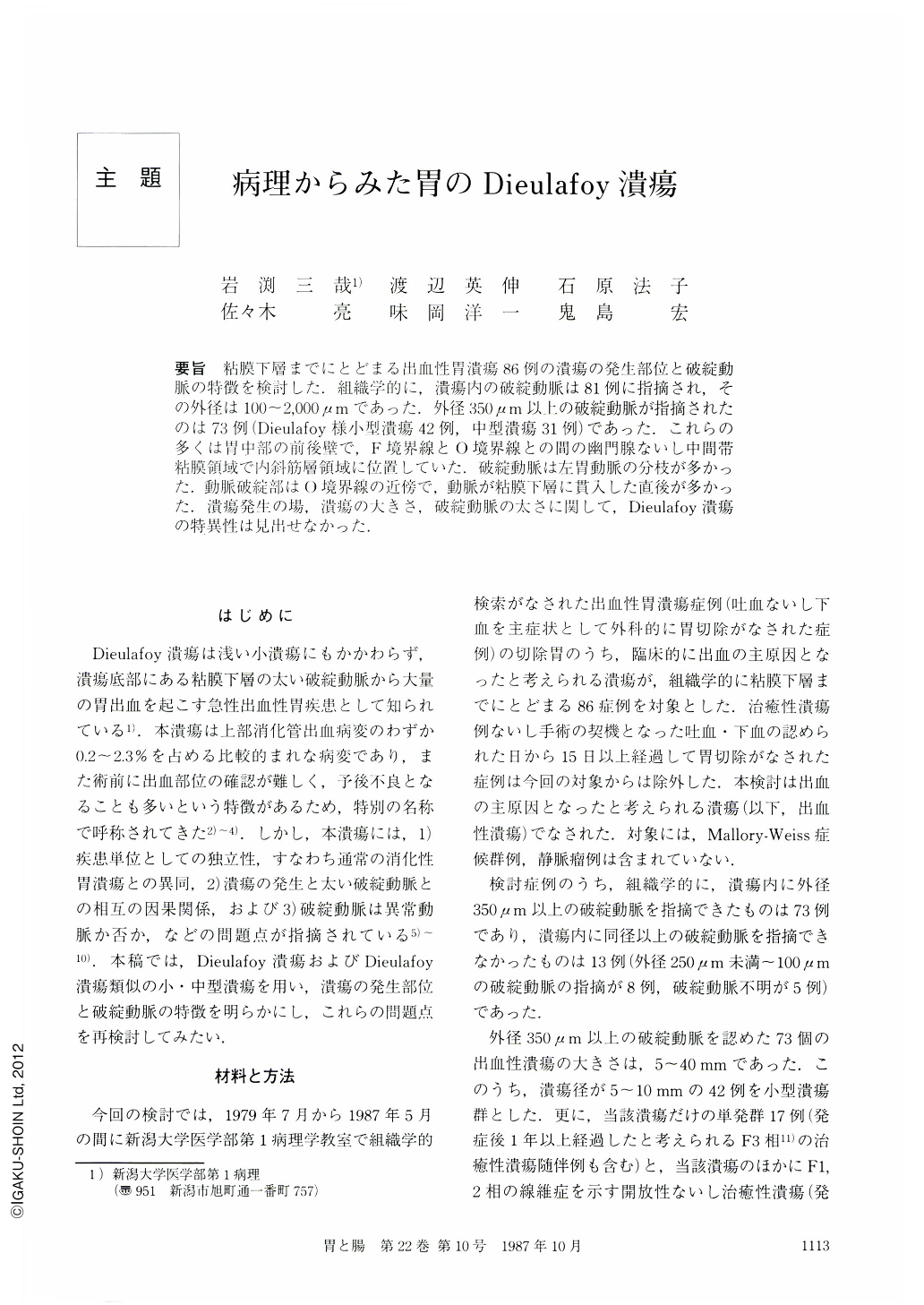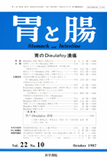Japanese
English
- 有料閲覧
- Abstract 文献概要
- 1ページ目 Look Inside
- サイト内被引用 Cited by
要旨 粘膜下層までにとどまる出血性胃潰瘍86例の潰瘍の発生部位と破綻動脈の特徴を検討した.組織学的に,潰瘍内の破綻動脈は81例に指摘され,その外径は100~2,000μmであった.外径350μm以上の破綻動脈が指摘されたのは73例(Dieulafoy様小型潰瘍42例,中型潰瘍31例)であった.これらの多くは胃中部の前後壁で,F境界線とO境界線との間の幽門腺ないし中間帯粘膜領域で内斜筋層領域に位置していた.破綻動脈は左胃動脈の分枝が多かった.動脈破綻部はO境界線の近傍で,動脈が粘膜下層に貫入した直後が多かった.潰瘍発生の場,潰瘍の大きさ,破綻動脈の太さに関して,Dieulafoy潰瘍の特異性は見出せなかった.
Eighty-six cases of open and hemorrhagic gastric ulcer limited to the submucosa were examined. All materials were surgically obtained within 14 days after bleeding. Two groups were identified; one (73 cases) with eroded arteries larger than 350μm in diameter in the ulcer base and another (13 cases) without such arteries. The former group consisted of 42 cases with small hemorrhagic ulcer of 10 mm or less in size (socalled exulceratio simplex of Dieulafoy) and 31 cases with ulcer of 11 to 40 mm in size.
Regardless of the size, 59 of 73 hemorrhagic ulcers with eroded arteries were located in the middle portion of the stomach and 62 on the posterior wall. Histologically, 68 of them occurred in the part of the inner oblique muscle layer-area covered by the atrophic pyloric or intermediate mucosa, i.e., the part between the Oboundary line (outline of the inner oblique muscle layer-area) and the F-boundary line (outline of the fundic gland-area). Most of the eroded arteries of 350 to 2,000 (mean: about 970) μm in diameter in these 70 cases were the branches of the left gastric artery along the lesser curvature, penetrating through the proper muscle layer in the vicinity of the O-boundary line and running in the submucosa of the inner oblique muscle layer-area on the posterior and anterior walls. The erosion of the arteries occurred at the elevated portion immediately after the penetration. The arteries lacked local dilatation or narrowing and degenerative changes, except for marked arteriolosclerosis noted in five cases. Non-eroded arteries of larger or the same diameter as those eroded were found in the submucosa outside the hemorrhagic ulcer in 56 of 73 cases of hemorrhagic ulcer. All but three cases lacked eroded arteries of 350 μm or greater in diameter in the associated open and healed ulcers.
Forteen sugically resected stomachs without hemorrhagic ulcer were examined by totally cut step-sections. Fifty arteries of between 500 and 1,000μm in diameter were found in all of the stomachs examined and 15 arteries of between 1,000 and 1,300μm in diameter in 12 stomachs. Almost all arteries of that size had the histologic characteristics comparable to those of the eroded arteries in the hemorrhagic ulcers, i.e., originating from the left gastric artery along the lesser curvature, penetrating through the proper muscle near the Oboundary line, distributing in the submucosa of the inner oblique muscle layer-area on the posterior and anterior walls and running the course without changing its caliber.
In summary, there was no characteristics distinguishing exulceratio simplex (Dieulafoy) of the stomach from medium-sized hemorrhagic gastric ulcer with respect to the site and type of the eroded arteries. In most cases, bleeding of exulceratio simplex of the stomach were thought to occur due to rupture of large arteries secondarily to accidental ulceration just above them. The eroded arteries in most cases with exulceratio simplex (Dieulafoy) of the stomach were not necessarily abnormal arteries.

Copyright © 1987, Igaku-Shoin Ltd. All rights reserved.


